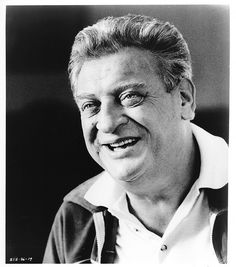 "ttyymmnn" (ttyymmnn)
"ttyymmnn" (ttyymmnn)
12/11/2015 at 12:35 • Filed to: planelopnik, planelopnik history
 9
9
 12
12
 "ttyymmnn" (ttyymmnn)
"ttyymmnn" (ttyymmnn)
12/11/2015 at 12:35 • Filed to: planelopnik, planelopnik history |  9 9
|  12 12 |
Welcome to This Date in Aviation History , getting you caught up on milestones and important historical events in aviation from December 9 through December 11.
!!! UNKNOWN CONTENT TYPE !!!
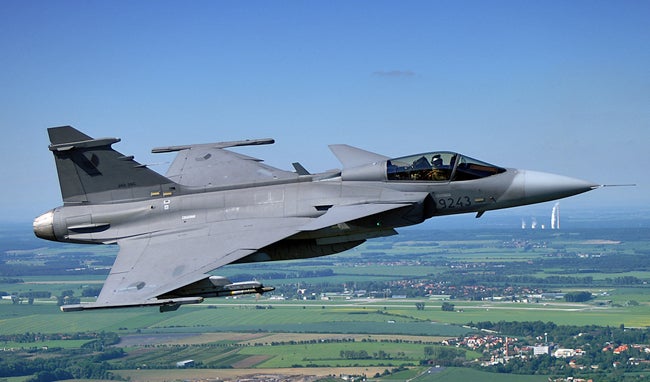
December 9, 1988 – The first flight of the JAS 39 Gripen. By the late 1970s, the !!!error: Indecipherable SUB-paragraph formatting!!! ( Flygvapnet ) began the search for a new fighter to replace the !!!error: Indecipherable SUB-paragraph formatting!!! and !!!error: Indecipherable SUB-paragraph formatting!!! , both of which had been serving since the mid-1950s and mid-1960s respectively. In 1979, the Swedish government issued a requirement for a Mach 2, multi-role fighter, specifically one that could perform air-to-air ( Jakt ), ground attack ( Attack ) and reconnaissance ( Spaning ) missions, hence the JAS prefix for the new fighter. While several designs were considered, the Flygvapnet settled on a single engine aircraft with a delta wing and forward canards, fly-by-wire controls and an inherently unstable design, also known as !!!error: Indecipherable SUB-paragraph formatting!!! . While it may seem odd to design an unstable aircraft, such instability, when teamed with redundant flight control computers, can result in an aircraft that is extremely maneuverable, as smaller control inputs are necessary to maneuver the aircraft, along with a reduction in drag and an increase in control response. In addition to the high maneuverability of the unstable design, the forward canard helps provide lift in all flight regimes, and aids in the short takeoff capability of the Gripen. This capability was a requirement of the fighter’s design as Sweden has used existing roadways for flight operations since the 1950s as part of an airfield dispersal program. The JAS 39 was also designed to be simple to maintain, and Saab hopes that the Gripen will be one of the few aircraft to join the ranks of aircraft with 50-years of service. The new fighter would be powered by !!!error: Indecipherable SUB-paragraph formatting!!! , a license-built derivative of the !!!error: Indecipherable SUB-paragraph formatting!!! . The name Gripen was chosen in a public contest to name the new fighter, and translates as !!!error: Indecipherable SUB-paragraph formatting!!! , the creature featured in the Saab !!!error: Indecipherable SUB-paragraph formatting!!! . The Swedish Air Force placed an initial order for 204 Gripens to be delivered in three batches, and took delivery of the first fighter in 1993. The first Gripens entered service in 1996. The JAS 39A was the initial single seat version, and was fitted with a single 27 mm !!!error: Indecipherable SUB-paragraph formatting!!! !!!error: Indecipherable SUB-paragraph formatting!!! and eight external hard points for rockets, missiles or bombs. The JAS 39B was a two-seat variant for training and type conversion, but in order to accommodate the second pilot the gun was removed. The JAS 39C is the NATO compatible version, and can be refueled in flight by NATO aircraft. The Gripen NG is a further improved and modernized version, and Saab is also considering a navalized variant. In addition to its home country, the Gripen is exported to seven other countries, with a host of other countries showing interest in obtaining the fighter. (Photo by Milan Nykodym via !!!error: Indecipherable SUB-paragraph formatting!!! )
!!! UNKNOWN CONTENT TYPE !!!
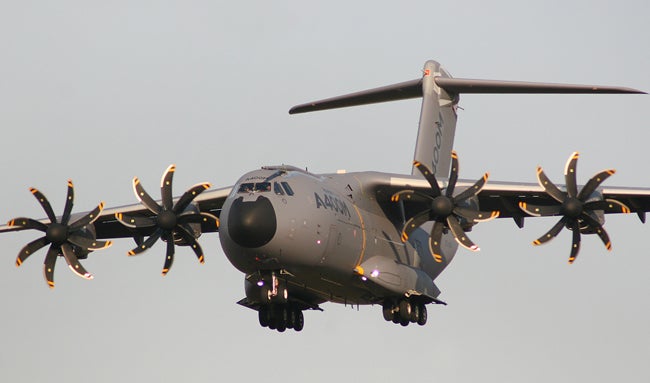
December 11, 2009 – The first flight of the Airbus A400M Atlas. Development of the A400M began in 1982 when a consortium of aircraft manufacturers including the French Aérospatiale, British Aerospace, Lockheed and Messerschmitt-Bölkow-Blohm formed a group to develop what was called the Future International Airlifter to replace older transport and cargo aircraft such as the !!!error: Indecipherable SUB-paragraph formatting!!! and the !!!error: Indecipherable SUB-paragraph formatting!!! , with the new airlifter fitting in size between the C-130 and the !!!error: Indecipherable SUB-paragraph formatting!!! . International politics being what they are, Lockheed eventually left the group to develop the upgraded !!!error: Indecipherable SUB-paragraph formatting!!! , and other European nations have since come and gone. With no existing turboprop engine powerful enough to provide the requisite performance, and after a request for proposals, Pratt & Whitney Canada was selected to provide their !!!error: Indecipherable SUB-paragraph formatting!!! engine, but, as the result of more international political intrigue, Airbus eventually chose the !!!error: Indecipherable SUB-paragraph formatting!!! -D6 which provides 11,000 hp each. To negate crontrol problems from engine torque, the A400M features counter-rotating props, but interestingly, all the engines turn in the same direction, with two of the propellers being reversed through a gearbox. This allows for commonality among all four engines to simplify maintenance and reduce cost. Airbus states that the Atlas has a range of over 5,000 miles at an altitude of 37,000 feet with a maximum payload of 81,000 pounds, or nearly twice that of the C-130J. It also features autonomous cargo loading and unloading allowing cargo transfer to be carried out by a single loadmaster. As with any new, complex aircraft, delays pushed the delivery dates farther and farther back, with initial deployment deferred from 2009 to 2012. The French Air Force completed the first operational mission of the A400M in December of 2013 in support of !!!error: Indecipherable SUB-paragraph formatting!!! in Mali, and the British made their first operational flight in 2015 with a mission to RAF Akrotiri in Cyprus. The A400M suffered its first fatal accident in May 2015 when engine mapping software was inadvertently erased and the engines failed to provide power during takeoff. Four employees of Spanish Airbus were killed, and two were seriously injured. A total of 174 aircraft have been ordered so far, with thirteen deliveries completed. (Photo by Curimedia via !!!error: Indecipherable SUB-paragraph formatting!!! )
!!! UNKNOWN CONTENT TYPE !!!
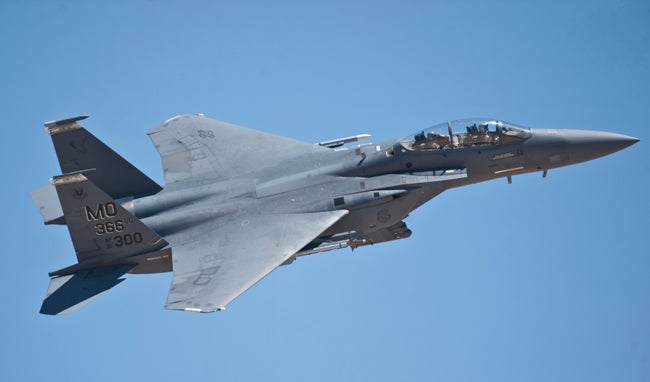
December 11, 1986 – The first flight of the McDonnell Douglas F-15E Strike Eagle.
In the late 1960s, the US Air Force began looking for a new fighter to replace the
!!!error: Indecipherable SUB-paragraph formatting!!!
, and from that search came the
!!!error: Indecipherable SUB-paragraph formatting!!!
. The Eagle was designed from the outset to be an air superiority fighter, meaning that it would take command of the airspace over the battlefield and maintain control of it, but the Air Force gave little thought for what was actually taking place on the ground. In fact, the F-15 Special Projects Office vehemently opposed the idea of the Eagle directly supporting the troops on the ground, or taking part in air-to-ground missions, saying, “Not a pound for air to ground.” But in spite of no official support for a ground attack version of the Eagle, McDonnell Douglas still worked quietly on an advanced, multi-role version of the Eagle in the hopes that opinions in the Air Force might change. By 1981, the Air Force came around, and announced the Enhanced Tactical Fighter program to find a replacement for the
!!!error: Indecipherable SUB-paragraph formatting!!!
. The idea was that such a fighter could strike deep into enemy territory without requiring fighter escort or electronic jamming provided by additional aircraft, and also have the ability to defend itself from aerial attack. General Dynamics responded with the
!!!error: Indecipherable SUB-paragraph formatting!!!
, a cranked delta version of their successful
!!!error: Indecipherable SUB-paragraph formatting!!!
, and McDonnell Douglas rolled out the F-15E they had been working on. After a two-year evaluation, the Air Force selected the F-15E, which proved to be capable of takeoff weights in excess of 75,000 pounds and had the ability to operate with sixteen different weapon configurations. Other factors in the Air Force’s decision were the reduced development costs, future growth potential, and the added safety of two engines. The F-15E is very similar in appearance to the original F-15, but the most apparent difference is the addition of a second seat for the
!!!error: Indecipherable SUB-paragraph formatting!!!
(WSO) and a darker camouflage pattern. The fuselage was redesigned and strengthened to accept more powerful engines, and
!!!error: Indecipherable SUB-paragraph formatting!!!
were added to the sides of the fuselage to extend range. And, unlike other two-seat aircraft with a WSO, such as the
!!!error: Indecipherable SUB-paragraph formatting!!!
, the rear seat has controls to fly the plane if necessary. The Strike Eagle was introduced in 1988, and soon saw action in the skies over Iraq and Kuwait in
!!!error: Indecipherable SUB-paragraph formatting!!!
, and has since gone on to fight in all major operations since. The F-15E remains in production, with over 420 built, and in addition to its service with the US Air Force, the Strike Eagle also flies for the air forces of Israel, South Korea, Saudi Arabia and Singapore.
(US Air Force photo)
!!! UNKNOWN CONTENT TYPE !!!
Short Take Off
!!! UNKNOWN CONTENT TYPE !!!
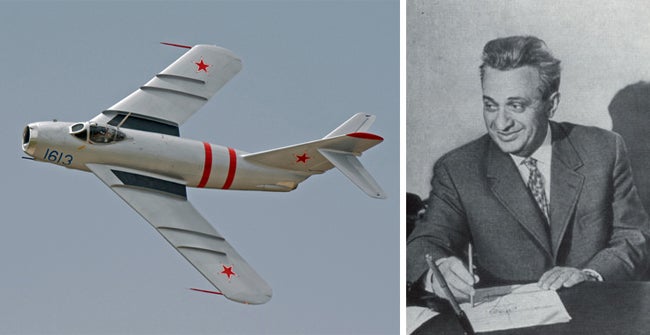
December 9, 1970 – The death of Artem Mikoyan,
a Russian aviation designer of Armenian descent who partnered with
!!!error: Indecipherable SUB-paragraph formatting!!!
to design many of the most important Soviet military aircraft of the Cold War and beyond. Mikoyan designed his first airplane as part of the
!!!error: Indecipherable SUB-paragraph formatting!!!
, graduating in 1936. By 1939, he had teamed with Gurevich to form the Mikoyan-Gurevich design bureau (MiG), and while their wartime designs were unsuccessful, their post-war jet design made them famous, beginning with the swept-wing MiG-15 and including many more advanced designs to counter Western militaries. Mikoyan twice received the Soviet Union’s highest award, the
!!!error: Indecipherable SUB-paragraph formatting!!!
.
!!! UNKNOWN CONTENT TYPE !!!
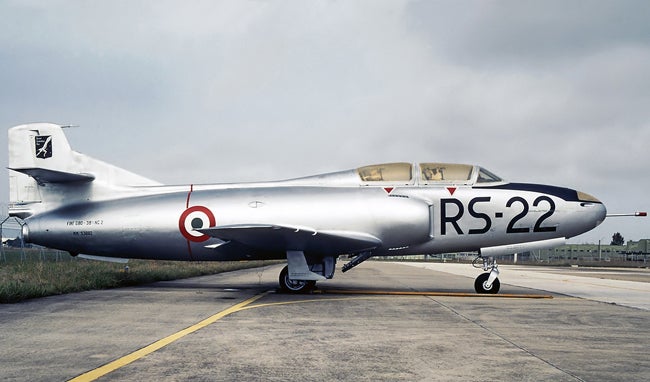
December 9, 1951 – The first flight of the Fiat G.80, a tandem jet trainer and the first true jet aircraft designed by Italy. The fighter was powered by a single !!!error: Indecipherable SUB-paragraph formatting!!! 2/21 !!!error: Indecipherable SUB-paragraph formatting!!! , and Fiat built two prototypes, followed by three production aircraft. However, the Italian Air Force found the G.80 to be unsuitable for operations and did not accept them. Fiat followed the G.80 with the G.82 in hopes of securing a NATO contract, but when the competition was cancelled the G.82 was cancelled as well after six aircraft were built. (Photo by Aldo Bidini via Wikimedia Commons)
!!! UNKNOWN CONTENT TYPE !!!
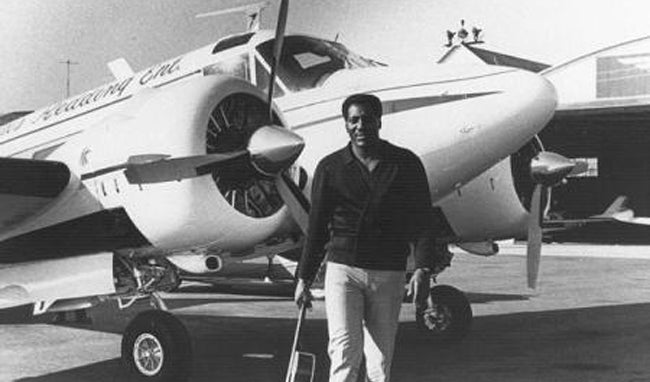
December 10, 1967 – Singer Otis Redding is killed in an air crash.
Redding and his band, the Bar-Kays, were traveling from Cleveland, Ohio to Madison, Wisconsin in Redding’s
!!!error: Indecipherable SUB-paragraph formatting!!!
. While flying in heavy rain and fog, the aircraft crashed into a lake three miles short of the runway at Truax Field in Madision, killing the pilot and six of the seven passengers. The only survivor was band member Ben Cauley. The official NTSB accident report lists the cause of the crash as “undetermined.”
(Photo author unknown)
!!! UNKNOWN CONTENT TYPE !!!
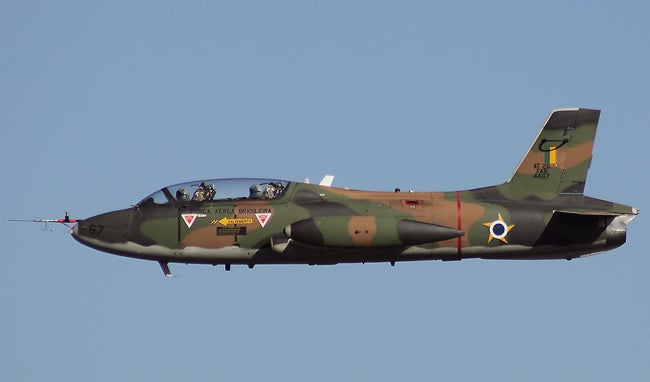
December 10, 1957 – The first flight of the Aermacchi MB-326. Without the means to produce supersonic aircraft following WWII, Italian designers focused on subsonic training and attack aircraft. The simple design of the MB-326 was both rugged and agile, and proved to be an ideal platform for all phases of jet pilot training. Initial production aircraft were powered by a single Bristol Siddeley Viper turbojet, the MB-326 proved to be an extremely successful design, and with 800 aircraft produced the MB-326 alone accounts for 10 percent of all aircraft ever built by Aermacchi. Developed as both a trainer and attack jet, the MB-326 served 16 countries, with the final aircraft being retired by Brazil in 2010. (Photo by Renato Spilimbergo Carvalho via !!!error: Indecipherable SUB-paragraph formatting!!! )
!!! UNKNOWN CONTENT TYPE !!!
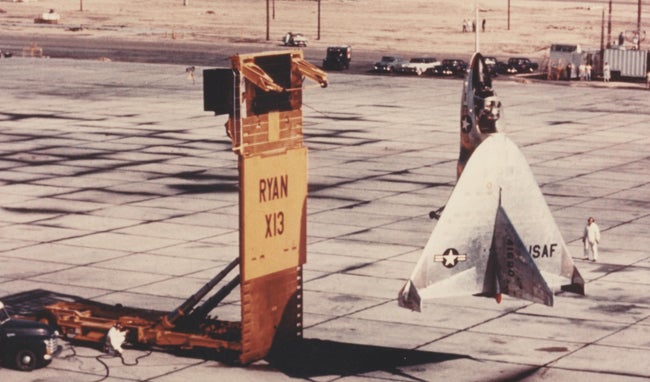
December 10, 1955 – The first flight of the Ryan X-13 Vertijet. The X-13 was developed to investigate the feasibility of a jet aircraft that could take of vertically, transition to level flight, then return to hover and land using only the rear engine. The idea was developed as a means to launch and recover aircraft from submarines. Two were built, and while it was proved that such an arrangement was possible, the project was canceled for lack of an operational requirement. (US Air Force photo)
!!! UNKNOWN CONTENT TYPE !!!
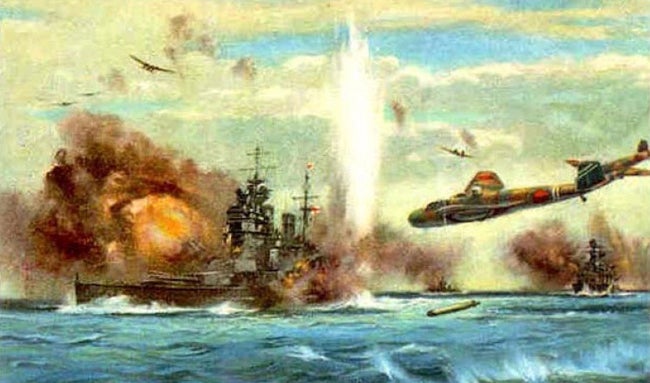
December 10, 1941 – Japanese aircraft sink the Royal Navy battleship HMS
Prince of Wales
and battlecruiser HMS
Repulse.
Prince of Wales
and
Repulse
were part of
!!!error: Indecipherable SUB-paragraph formatting!!!
, a naval squadron sent to intercept Japanese shipping in the waters off Singapore early in WWII. Admiral Sir Tom Phillips, in command of the squadron, decided to sail without air cover, and the ships were attacked by land-based Japanese Navy
!!!error: Indecipherable SUB-paragraph formatting!!!
and
!!!error: Indecipherable SUB-paragraph formatting!!!
aircraft carrying a mix of bombs and torpedoes. Both
Prince of Wales
and
Repulse
were hit by four torpedoes, and both sank with heavy loss of life. This marked the first time in history that air power had sunk capital ships that were actively fighting to defend themselves, and heralded the end of the battleship as the primary weapon of naval surface warfare.
(Illustration artist unknown)
!!! UNKNOWN CONTENT TYPE !!!
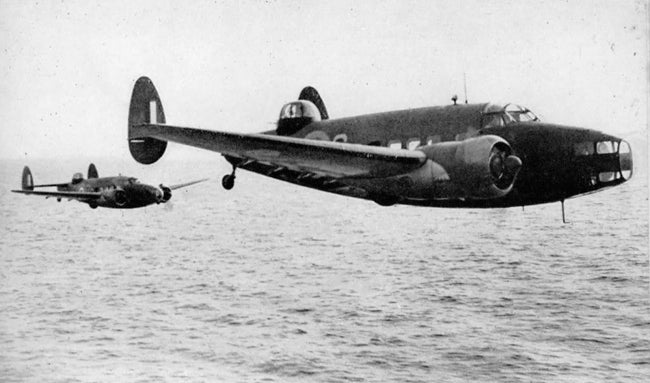
December 10, 1938 – The first flight of the Lockheed Hudson. A development of the !!!error: Indecipherable SUB-paragraph formatting!!! , the Hudson was built primarily for the Royal Air Force for use as a coastal reconnaissance aircraft, light bomber and in the anti-submarine warfare role . With the RAF’s initial order of 200 aircraft, the Hudson was the first major production aircraft for the !!!error: Indecipherable SUB-paragraph formatting!!! , and they eventually produced nearly 3000 Hudsons for the RAF, the Royal Canadian Air Force, the Royal Australian Air Force and the US Army Air Forces. Hudsons served throughout the war in both Europe and the Pacific, and were well known for their agility at the hands of a skilled pilot. (Photo author unknown)
!!! UNKNOWN CONTENT TYPE !!!
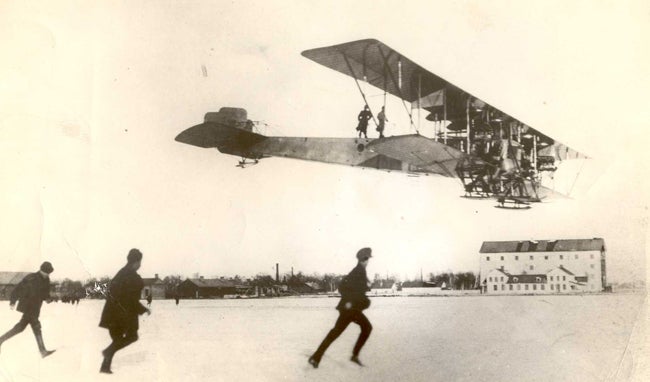
December 11, 1913 – The first flight of the Sikorsky Ilya Muromets,
a large, four-engine bomber designed by Igor Sikorsky and developed from the earlier
!!!error: Indecipherable SUB-paragraph formatting!!!
. Originally intended as a large passenger aircraft, the Ilya Muromets was developed into a bomber as WWI approached, and by 1918, eighty-three bombers had been produced. They were the first aircraft in aviation history to perform heavy bombing missions, group raids, night bombings and photo reconnaissance. In 400 sorties, the Ilya Muromets dropped sixty-five tons of bombs. Following the war, the Muromets returned to its original role of passenger aircraft and mail plane, with the final flight taking place in 1922.
(Photo author unknown)
!!! UNKNOWN CONTENT TYPE !!!
!!! UNKNOWN HEADER TYPE (MULTI-LINE BREAK?) !!!
!!! UNKNOWN CONTENT TYPE !!!
!!! UNKNOWN CONTENT TYPE !!!
!!! UNKNOWN CONTENT TYPE !!!
!!! UNKNOWN CONTENT TYPE !!!
If you enjoy these Aviation History posts, please let me know in the comments. And if you missed any of the past articles, you can find them all at
!!!error: Indecipherable SUB-paragraph formatting!!!
.
!!! UNKNOWN CONTENT TYPE !!!
 For Sweden
> ttyymmnn
For Sweden
> ttyymmnn
12/11/2015 at 12:45 |
|
(._.)7
 RallyWrench
> ttyymmnn
RallyWrench
> ttyymmnn
12/11/2015 at 12:48 |
|
I start waving my canards around under relaxed stability after a few beers.
 ttyymmnn
> For Sweden
ttyymmnn
> For Sweden
12/11/2015 at 12:49 |
|
You’ll forgive me, but I have no idea what that emoticon means.
 ttyymmnn
> RallyWrench
ttyymmnn
> RallyWrench
12/11/2015 at 12:50 |
|
Nobody wants to see your canards....
 Dukie - Jalopnik Emergency Management Asshole
> ttyymmnn
Dukie - Jalopnik Emergency Management Asshole
> ttyymmnn
12/11/2015 at 13:00 |
|
I still think the F-16XL is the best looking F-16 GD made.
 RamblinRover Luxury-Yacht
> ttyymmnn
RamblinRover Luxury-Yacht
> ttyymmnn
12/11/2015 at 13:06 |
|
Guy doing a salute, apparently.
 RallyWrench
> ttyymmnn
RallyWrench
> ttyymmnn
12/11/2015 at 13:07 |
|
I flap my canards in your general direction.
 The Powershift in Steve's '12 Ford Focus killed it's TCM (under warranty!)
> ttyymmnn
The Powershift in Steve's '12 Ford Focus killed it's TCM (under warranty!)
> ttyymmnn
12/11/2015 at 13:14 |
|
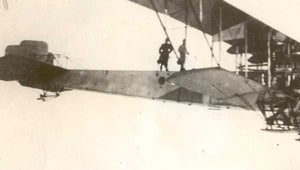
This is proof that the Russians have always been crazy.
 MonkeePuzzle
> ttyymmnn
MonkeePuzzle
> ttyymmnn
12/11/2015 at 14:16 |
|
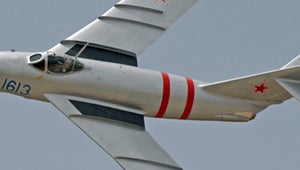
this season of jet aircraft, was truly just tube shaped engine with wings.
 MonkeePuzzle
> ttyymmnn
MonkeePuzzle
> ttyymmnn
12/11/2015 at 14:17 |
|
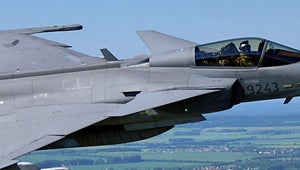
gripen, draken, viggen, man they have cool names. I love the backwards seeming design they have, it feels so futuristic
 ttyymmnn
> MonkeePuzzle
ttyymmnn
> MonkeePuzzle
12/11/2015 at 14:23 |
|
Yup, pretty much.
 You can tell a Finn but you can't tell him much
> ttyymmnn
You can tell a Finn but you can't tell him much
> ttyymmnn
12/11/2015 at 15:43 |
|
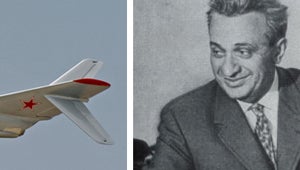
He looks like a Russian Rodney Dangerfield.
